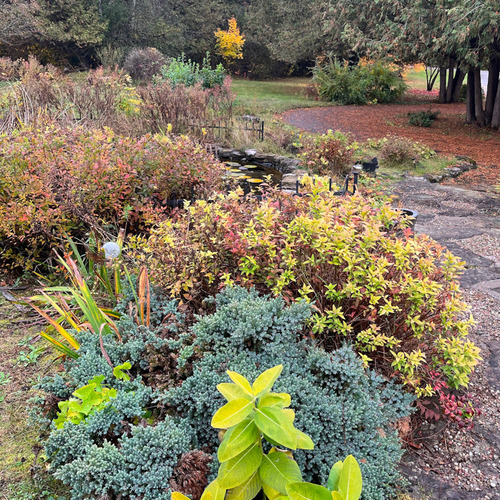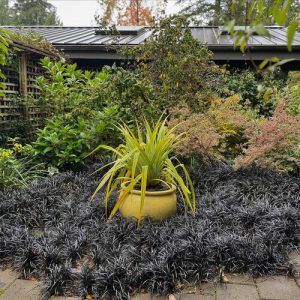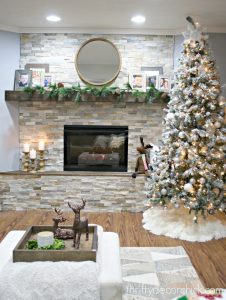
We’re off to Canada today to visit Anne’s garden.
You have visited my garden before (A Garden That Works With Nature Instead of Fighting It). We are located not far from Ottawa, Ontario, in a rural development. I thought it would be nice to visit it in autumn, a few years later.
Gardening on the edge of an arid alvar environment is sometimes a challenge but often a delight. The trick is to work with the environment instead of trying to change it. The limestone outcroppings all over our garden are a feature of the alvar environment, and we have embraced them.
Since the last time, I have added a permaculture berm in a corner of the front yard and have grown some pumpkin and squash on it. I have continued to encourage native plants in the borders (e.g., asters, goldenrods, columbines) and have noticed a distinct increase in pollinators visiting. I have also planted a pollinator garden area on the side (anise hyssop, echinops, lysimachia, etc.) and have taken out some invasive species (Norway maple, European buckthorn). The latter is still a major issue.
The garden is an ever-changing organism. Sometimes it’s difficult to keep on top of it, but then, nature has its way.
I hope you enjoy my fall garden.
In this mid-fall view from the road at the entrance to the property you can see red maple (Acer rubrum, Zones 3–9), staghorn sumac (Rhus typhina, Zones 3–8), ivory silk lilac (Syringa reticulata, Zones 3–7), and Ginkgo biloba (Zones 3–8).
 The staghorn sumac in fall color
The staghorn sumac in fall color
 Around the pond there is a potted mum (Chrysanthemum hybrid, hardiness varies by cultivar) along with Hemerocallis (Zones 3–8), New England aster (Symphyotrichum novae-angliae, Zones 4–8), and Van Houtte spirea (Spiraea × vanhottei, Zones 3–8).
Around the pond there is a potted mum (Chrysanthemum hybrid, hardiness varies by cultivar) along with Hemerocallis (Zones 3–8), New England aster (Symphyotrichum novae-angliae, Zones 4–8), and Van Houtte spirea (Spiraea × vanhottei, Zones 3–8).
 A photo from early fall shows Hydrangea paniculata ‘Vanilla Strawberry’ (Zones 3–8), Rudbeckia fulgida (Zones 3–9), and Paeonia (Zones 3–8) leaves.
A photo from early fall shows Hydrangea paniculata ‘Vanilla Strawberry’ (Zones 3–8), Rudbeckia fulgida (Zones 3–9), and Paeonia (Zones 3–8) leaves.
 The bounty of a permaculture patch from a previous year—squash and pink pumpkins!
The bounty of a permaculture patch from a previous year—squash and pink pumpkins!
 Including this New England aster, we have at least three varieties of native asters on the property.
Including this New England aster, we have at least three varieties of native asters on the property.
 Hydrangeas in deep fall still show signs of life, but the phlox (Phlox paniculata, Zones 5–9) and goldenrod (Solidago sp.) are spent.
Hydrangeas in deep fall still show signs of life, but the phlox (Phlox paniculata, Zones 5–9) and goldenrod (Solidago sp.) are spent.
 Under the cedars: a view of the front garden in deep fall
Under the cedars: a view of the front garden in deep fall
 Here is the front walk looking toward the road, with the permaculture berm in the distance on the left. The property is dominated by cedars (Thuja occidentalis, Zones 2–7), which are native to this alvar-bordering region.
Here is the front walk looking toward the road, with the permaculture berm in the distance on the left. The property is dominated by cedars (Thuja occidentalis, Zones 2–7), which are native to this alvar-bordering region.
 The cedars have shed their autumn leaves. Native milkweed (Asclepias syriaca, Zones 3–9) leaves are turning gold in the foreground.
The cedars have shed their autumn leaves. Native milkweed (Asclepias syriaca, Zones 3–9) leaves are turning gold in the foreground.
Have a garden you’d like to share?
Have photos to share? We’d love to see your garden, a particular collection of plants you love, or a wonderful garden you had the chance to visit!
To submit, send 5-10 photos to [email protected] along with some information about the plants in the pictures and where you took the photos. We’d love to hear where you are located, how long you’ve been gardening, successes you are proud of, failures you learned from, hopes for the future, favorite plants, or funny stories from your garden.
Have a mobile phone? Tag your photos on Facebook, Instagram or Twitter with #FineGardening!
Do you receive the GPOD by email yet? Sign up here.





